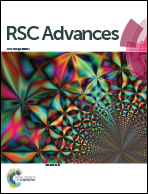Interfacial self-assembly of nanoporous C60 thin films†
Abstract
Nanoporous surface morphologies often perform better than their planar or bulk counterparts in phenomena such as catalysis and charge transport. In organic photovoltaics, for example, fullerene films structured on a scale corresponding to the exciton diffusion length, typically a few tens of nanometers, could improve charge separation. Existing methods to form such films, however, typically do not reach features smaller than 100 nm. Here, we propose a simple method based on interfacial nucleation and growth to produce large and flexible 2D percolating assemblies of C60 nanoparticles with diameters below 50 nm that cover up to 60% of the surface. These films can be rendered insoluble by photopolymerization and infiltrated with other functional molecules. We illustrate the benefit of such stabilized nanoporous films on the example of organic solar cells of the architecture ITO/TiO2/C60/P3HT/MoO3/Ag. Structured C60 films with interconnected morphological features perform better than planar C60 films by 50% on average, reaching a power conversion efficiency of 1.3%. Due to the ease of film fabrication and small dimensions of the C60 morphological features, these results may find application beyond organic photovoltaics, in a variety of fields where an enhanced interface with a fullerene surface is needed.


 Please wait while we load your content...
Please wait while we load your content...